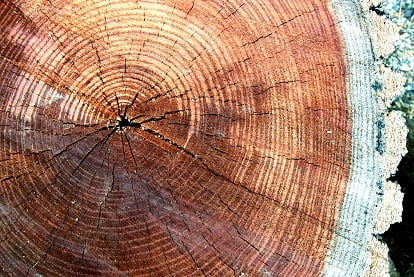Cooling Tower Fundamentals: The Evolution of Wooden Cooling Towers
Cooling tower construction has evolved over time as environmental concerns and new materials have become available. Although FRP is now the preferred building material, the transition from wood cooling towers to more durable materials is an interesting journey beginning with redwood construction.
The Beginning: Wooden Cooling Towers
At the very beginning of cooling tower construction, the natural ability of redwood to inhibit decay made it the preferred material for cooling tower construction. Eventually redwood supply diminished and the building material of choice, while still wood, began to shift to Douglas Fir. While stronger, Douglas Fir decayed much faster than Redwood. To combat the decay of cooling tower lumber pressure treatment and incising were employed.
In the pressure treatment process, an aqueous solution of CCA is applied using a vacuum and pressure cycle, and the treated wood is then stacked to dry. During the process, the mixture of oxides reacts to form insoluble compounds, helping with leaching problems.
The process can apply varying amounts of preservative at varying levels of pressure to protect the wood against increasing levels of attack. Increasing protection can be applied (in increasing order of attack and treatment) for: exposure to the atmosphere, implantation within soil, or insertion into a marine environment.
Incising encourages the wood to accept chemical treatment by the process of adding small incisions along the wood.
Environmental concerns began to take their toll on wooden cooling towers as public consciousness of leaching grew. Concerns over leaching, the loss of wood preservative chemicals into the water flowing though a cooling tower, eventually led to stricter industry controls and new chemical preservative formulas. Combined with advances in steel construction, the growing cost of combating environmental concerns about wooden cooling towers caused the building material to fall out of favor.
The Ups and Downs of Steel
Type 304 stainless steel became more popular as the corrosion potential increased. Manufacturers simply substituted stainless steel for galvanized steel components. Due to cost constraints, just the cold water basin was typically up graded to SST. There were some unfortunate occasions where galvanized and stainless steels were fastened together below the water line causing rapid deterioration of the galvanized steel at the joint from galvanic action. Anyone considering mixing these materials must pay attention to the surrounding materials- particularly the fasteners. Such joints should never occur below the overflow level of the cooling tower.
Specifiers will sometimes call for type 316 SST. This is ok for nuts, bolts, and some small sub assemblies but it is largely incompatible with the tooling used by the manufacturers. It is also difficult to form. For these reasons, it is largely unavailable.
The galvanized steel cooling tower has remained the factory assembled standard. The thickness of the steel has steadily declined with more economical designs but the thickness of the zinc layer has steadily increased to a current standard of G235. (Or, 2.35oz. of zinc per sq. ft.) from a 1970’s standard of G90 (.90 oz/sq.ft.). This thickening of the sacrificial zinc layer has a very beneficial effect on cooling tower life.
Various enhancements to the galvanized steel in the form of barriers have been employed by some manufacturers. Their suitability largely depends on the local water quality.
Concrete can be an excellent construction material for basins- even side walls, fan decks, discharge stacks, and mechanical support beams. Its use beyond basins, however is not typically justified for commercial applications. Extensive concrete construction is used for architectural reasons- where the tower is disguised to look like or blend in with a building- or, the cooling tower is designed as a structure with a life expectancy equal to the facility it serves such as a hospital or university.
The New Age: FRP
FRP offers a number of advantages over traditional cooling tower construction. Fiberglass reinforced plastics advantages include:
- Strength
- Corrosion resistance
- UV resistance
- Ability to add surface treatments
















